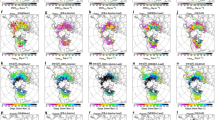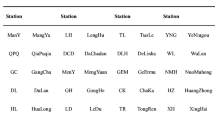Abstract
The soil temperature (ST) is closely related to the surface air temperature (AT), but their coupling may be affected by other factors. In this study, significant effects of the AT on the underlying ST were found, and the time taken to propagate downward to 320 cm can be up to 10 months. Besides the AT, the ST is also affected by memory effects—namely, its prior thermal conditions. At deeper depth (i.e., 320 cm), the effects of the AT from a particular season may be exceeded by the soil memory effects from the last season. At shallower layers (i.e., < 80 cm), the effects of the AT may be blocked by the snow cover, resulting in a poorly synchronous correlation between the AT and the ST. In northeastern China, this snow cover blockage mainly occurs in winter and then vanishes in the subsequent spring. Due to the thermal insulation effect of the snow cover, the winter ST at layers above 80 cm in northeastern China were found to continue to increase even during the recent global warming hiatus period. These findings may be instructive for better understanding ST variations, as well as land-atmosphere interactions.
摘 要
土壤温度与地表气温密切相关,但两者之间的耦合会受到多种因素的影响。本文基于中国地表气温、积雪及多层土壤温度资料,利用线性相关及非线性因果分析方法研究了不同因素对土壤温度的影响。研究发现,地表气温可以显著的影响多层土壤温度,但随土壤深度的增加,地表气温的影响逐渐变弱且向下传递其影响所需的时间变长。地表气温的影响最长需要10个月才能传递到320厘米深的土壤。除了受地表气温的影响,土壤温度本身的记忆性特征也可以对未来的土壤温度产生显著的影响。在深层土壤(如320厘米),前一季度土壤温度记忆性对当季的影响甚至可以超过同期来自地表气温的影响。在浅层土壤(如80厘米以上),地表气温与土壤温度的耦合可能会被积雪阻挡。这种阻挡作用在我国东北地区的冬季尤其显著。受积雪的保温作用影响,即便是在本世纪初以来的全球变暖停滞期,我国东北地区冬季浅层土壤(80厘米以上)温度依旧保持升温趋势。这些研究结果有助于更好的理解多层土壤温度变率以及开展地-气相互作用的研究。
Similar content being viewed by others
References
Beltrami, H., and L. Kellman, 2003: An examination of short-and long-term air-ground temperature coupling. Global and Planetary Change, 38(3–4), 291–303, https://doi.org/10.1016/s0921-8181(03)00112-7.
Beltrami, H., G. Ferguson, and R. N. Harris, 2005: Long-term tracking of climate change by underground temperatures. Geophys. Res. Lett., 32(19), L19707, https://doi.org/10.1029/2005GL023714.
Chudinova, S. M., O. W. Frauenfeld, R. G. Barry, T. J. Zhang, and V. A. Sorokovikov, 2006: Relationship between air and soil temperature trends and periodicities in the permafrost regions of Russia. J. Geophys. Res., 111, F02008, https://doi.org/10.1029/2005JF000342.
Cohen, J. L., J. C. Furtado, M. Barlow, V. A. Alexeev, and J. E. Cherry, 2012: Asymmetric seasonal temperature trends. Geophys. Res. Lett., 39, L04705, https://doi.org/10.1029/2011GL050582.
Fan, X. G., 2009: Impacts of soil heating condition on precipitation simulations in the weather research and forecasting model. Mon. Wea. Rev., 137(7), 2263–2285, https://doi.org/10.1175/2009MWR2684.1.
Fyfe, J. C., and Coauthors, 2016: Making sense of the early-2000s warming slowdown. Nature Climate Change, 6(3), 224–228, https://doi.org/10.1038/nclimate2938.
Hu, Q., and S. Feng, 2004a: A role of the soil enthalpy in land memory. J. Climate, 17(18), 3633–3643, https://doi.org/10.1175/1520-0442(2004)017<3633:AROTSE>2.0.CO;2.
Hu, Q., and S. Feng, 2004b: Why has the land memory changed? J. Climate, 17(16), 3236–3243, https://doi.org/10.1155/1520-0442(2004)017<3236:WHTLMC>2.0.CO;2.
Hu, Q., and S. Feng, 2005: How have soil temperatures been affected by the surface temperature and precipitation in the Eurasian continent? Geophys. Res. Lett., 22, L14711, https://doi.org/10.1029/2005GL023469.
Huang, Y., C. L. E. Franzke, N. M. Yuan, and Z. T. Fu, 2020: Systematic identification of causal relations in high-dimensional chaotic systems: Application to stratospheretroposphere coupling. Climate Dyn., 55, 2469–2481, https://doi.org/10.1007/s00382-020-05394-0.
Kosaka, Y., and S. P. Xie, 2013: Recent global-warming hiatus tied to equatorial Pacific surface cooling. Nature, 501(7467), 403–407, https://doi.org/10.1038/nature12534.
Luo, D. H., Y. A. Chen, A. Dai, M. Mu, R. H. Zhang, and S. Ian, 2017: Winter Eurasian cooling linked with the Atlantic multidecadal oscillation. Environmental Research Letters, 12(12), 125002, https://doi.org/10.1088/1748-9326/aa8de8.
Ma, H., S. Y. Leng, and L. N. Chen, 2018: Data-based prediction and causality inference of nonlinear dynamics. Science China Mathematics, 67(3), 403–420, https://doi.org/10.1007/s11425-017-9177-0.
Mahanama, S. P. P., R. D. Koster, R. H. Reichle, and M. J. Suarez, 2008: Impact of subsurface temperature variability on surface air temperature variability: An AGCM study. Journal of Hydrometeorology, 9(4), 804–815, https://doi.org/10.1175/2008JHM949.1.
McCracken, J. M., and R. S. Weigel, 2014: Convergent cross-mapping and pairwise asymmetric inference. Physical Review E, 90(6), 062903, https://doi.org/10.1103/PhysRevE.90.06.
Medhaug, I., M. B. Stolpe, E. M. Fischer, and R. Knutti, 2017: Reconciling controversies about the ‘global warming hiatus’. Nature,, 545(7652), 41–47, https://doi.org/10.1038/nature22315.
Mønster, D., R. Fusaroli, K. Tylén, A. Roepstorff, and J. F. Sherson, 2016: Inferring causality from noisy time series data-a test of convergent cross-mapping. Proc. 1st Int. Conf. on Complex Information Systems, Rome, Italy, 48–56, https://doi.org/10.5220/0005932600480056.
Mønster, D., R. Fusaroli, K. Tylén, A. Roepstorff, and J. F. Sherson, 2017: Causal inference from noisy time-series data-Testing the convergent cross-mapping algorithm in the presence of noise and external influence. Future Generation Computer Systems, 73, 52–62, https://doi.org/10.1016/j.future.2016.12.009.
Risbey, J. S., and S. Lewandowsky, 2017: Climate science: The ‘pause’ unpacked. Nature, 545(7652), 37–39, https://doi.org/10.1038/545037a.
Sugihara, G., and R. M. May, 1990: Nonlinear forecasting as a way of distinguishing chaos from measurement error in time series. Nature, 344(6268), 734–741, https://doi.org/10.1038/344734a0.
Sugihara, G., 1994: Nonlinear forecasting for the classification of natural time series. Philosophical Transactions of the Royal Society A: Mathematical Physical and Engineering Sciences, 438(1688), 477–495, https://doi.org/10.1988/rsta.1994.0106.
Sugihara, G., R. May, H. Ye, C. H. Hsieh, E. Deyle, M. Fogarty, and S. Munch, 2012: Detecting causality in complex ecosystems. Science, 338(6106), 496–500, https://doi.org/10.1126/science.1227079.
Takens, F., 1981: Detecting strange attractors in turbulence. Dynamical Systems and Turbulence, Warwick 1980, D. Rand and L. S. Young, Eds., Springer, 366–381, https://doi.org/10.1007/BFb0091924.
Tang, M. C., and E. R. Reiter, 1986: The similarity between the maps of soil temperature and precipitation anomaly of the subsequent season. Plateau Meteorology, 5, 293–307. (in Chinese)
Tang, M. C., J. X. Wang, and J. Zhang, 1987: A primary method for predicting the spring rainfall by the winter soil temperature depth 80cm. Plateau Meteorology, 6(3), 244–255. (in Chinese)
Tang, M. C., S. H. Sun, Q. Zhong, and S. J. Wu, 1982: The energy variation of the underlying surface and the changes of the weather and climate. Plateau Meteorology, 1(1), 24–34. (in Chinese)
Tang, Q. H., X. J. Zhang, X. H. Yang, and J. A. Francis, 2013: Cold winter extremes in northern continents linked to Arctic sea ice loss. Environmental Research Letters, 8(1), 014036, https://doi.org/10.1088/1748-9326/8/1/014036.
Trenberth, K. E., J. T. Fasullo, G. Branstator, and A. S. Phillips, 2014: Seasonal aspects of the recent pause in surface warming. Nature Climate Change, 4(10), 911–916, https://doi.org/10.1038/NCLIMATE2341.
Tsonis, A. A., E. R. Deyle, H. Ye, and G. Sugihara, 2018: Convergent cross mapping: Theory and an example. Advances in Nonlinear Geosciences, A. A. Tsonis, Ed., Springer, 587–600, https://doi.org/10.1007/978-3-319-58895-7_27.
Wang, C. Y., S. P. Xie, Y. Kosaka, Q. Y. Liu, and X. T. Zheng, 2017: Global influence of tropical Pacific variability with implications for global warming slowdown. J. Climate, 30(7), 2679–2695, https://doi.org/10.1175/JCLI-D-15-0496.1.
Wang, L., M. Henderson, B. H. Liu, X. J. Shen, X. W. Chen, L. Y. Lian, and D. W. Zhou, 2018a: Maximum and minimum soil surface temperature trends over China, 1965–2014. J. Geophys. Res., 123(4), 2004–2016, https://doi.org/10.1002/2017JD027283.
Wang, Y. Q., J. Yang, Y. N. Chen, P. De Maeyer, Z. Li, and W. L. Duan, 2018b: Detecting the causal effect of soil moisture on precipitation using convergent cross mapping. Scientific Reports, 8, 12171, https://doi.org/10.1038/s41598-018-30669-2.
Wu, L. Y., and J. Y. Zhang, 2014: Strong subsurface soil temperature feedbacks on summer climate variability over the arid/semi-arid regions of East Asia. Atmospheric Science Letters, 15(4), 307–313, https://doi.org/10.1002/asl2.504.
Xu, W. H., C. H. Sun, J. Q. Zuo, Z. G. Ma, W. J. Li, and S. Yang, 2019: Homogenization of monthly ground surface temperature in China during 1961–2016 and performances of GLDAS reanalysis products. J. Climate, 32(4), 1121–1135, https://doi.org/10.1175/JCLI-D-18-0275.1.
Xue, Y. K., R. Vasic, Z. Janjic, Y. M. Liu, and P. C. Chu, 2012: The impact of spring subsurface soil temperature anomaly in the western U.S. on North American summer precipitation: A case study using regional climate model downscaling. J. Geophys. Res., 117 D11103, https://doi.org/10.1029/2012JD017692.
Yang, K., and J. Y. Zhang, 2015: Spatiotemporal characteristics of soil temperature memory in China from observation. Theor. Appl. Climatol., 126(3–4), 739–749, https://doi.org/10.1007/s00704-015-1613-9.
Ye, H., E. R. Deyle, L. J. Gilarranz, and G. Sugihara, 2015: Distinguishing time-delayed causal interactions using convergent cross mapping. Scientific Reports, 5, 14750, https://doi.org/10.1038/srep14750.
Zhang, N. N., G. L. Wang, and A. A. Tsonis, 2019: Dynamical evidence for causality between Northern Hemisphere annular mode and winter surface air temperature over Northeast Asia. Climate Dyn., 52, 3175–3182, https://doi.org/10.1007/s00382-018-4317-x.
Zhang, T. J., 2005: Influence of the seasonal snow cover on the ground thermal regime: An overview. Rev. Geophys., 43, RG4002, https://doi.org/10.1029/2004RG000157.
Zhang, T., R. G. Barry, D. Gilichinsky, S. S. Bykhovets, V. A. Sorokovikov, and J. P. Ye, 2001: An amplified signal of climatic change in soil temperatures during the last century at Irkutsk, Russia. Climatic Change, 49(1–2), 41–76, https://doi.org/10.1023/A:1010790203146.
Acknowledgements
This work was sponsored by the National Key R&D Program of China (Grant No. 2016YFA0600404) and the National Natural Science Foundation of China (Grant Nos. 41530532 and 41675088). N. Y. also thanks the support from the Chinese Academy of Sciences Pioneer Hundred Talents Program.
Author information
Authors and Affiliations
Corresponding author
Additional information
Article Highlights
• Causal impacts from surface air temperature, snow cover, and soil memory, on the soil temperature are revealed.
• The snow cover in northeastern China led to a continuous warming of the winter soil at shallow layers (⩽ 80 cm) in the warming hiatus period.
• The soil memory in the deep layer (i.e., 320 cm) was found to play an important role in modulating the soil temperature variability.
Electronic Supplementary Material
376_2020_74_MOESM1_ESM.pdf
Understanding the Soil Temperature Variability at Different Depths: Effects of Surface Air Temperature, Snow Cover, and the Soil Memory
Rights and permissions
About this article
Cite this article
Zhang, H., Yuan, N., Ma, Z. et al. Understanding the Soil Temperature Variability at Different Depths: Effects of Surface Air Temperature, Snow Cover, and the Soil Memory. Adv. Atmos. Sci. 38, 493–503 (2021). https://doi.org/10.1007/s00376-020-0074-y
Received:
Revised:
Accepted:
Published:
Issue Date:
DOI: https://doi.org/10.1007/s00376-020-0074-y




